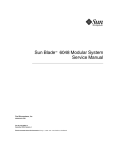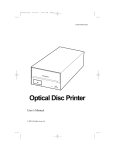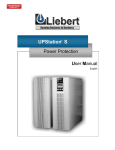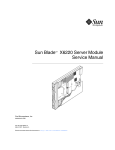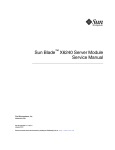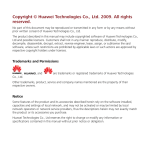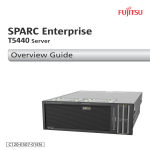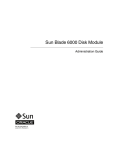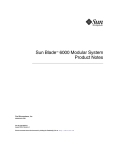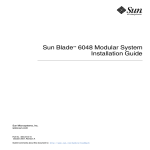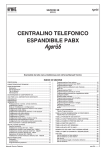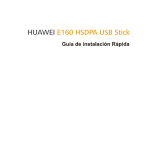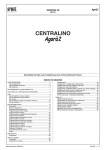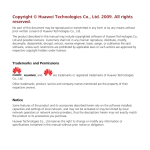Download Sun Blade 6000 Modular System Service Manual
Transcript
Sun Blade™ 6000 Modular System Service Manual Sun Microsystems, Inc. www.sun.com Part No. 820-0051-10 March 2007, Revision A Submit comments about this document at: http://www.sun.com/hwdocs/feedback Copyright 2007 Sun Microsystems, Inc., 4150 Network Circle, Santa Clara, California 95054, U.S.A. All rights reserved. Sun Microsystems, Inc. has intellectual property rights relating to technology that is described in this document. In particular, and without limitation, these intellectual property rights may include one or more of the U.S. patents listed at http://www.sun.com/patents and one or more additional patents or pending patent applications in the U.S. and in other countries. This document and the product to which it pertains are distributed under licenses restricting their use, copying, distribution, and decompilation. No part of the product or of this document may be reproduced in any form by any means without prior written authorization of Sun and its licensors, if any. Third-party software, including font technology, is copyrighted and licensed from Sun suppliers. Parts of the product may be derived from Berkeley BSD systems, licensed from the University of California. UNIX is a registered trademark in the U.S. and in other countries, exclusively licensed through X/Open Company, Ltd. Sun, Sun Microsystems, the Sun logo, Java, Solaris, and Sun Blade are trademarks or registered trademarks of Sun Microsystems, Inc. in the U.S. and in other countries. All SPARC trademarks are used under license and are trademarks or registered trademarks of SPARC International, Inc. in the U.S. and in other countries. Products bearing SPARC trademarks are based upon an architecture developed by Sun Microsystems, Inc AMD Opteron is a trademark or registered trademark of Advanced Microdevices, Inc. The OPEN LOOK and Sun™ Graphical User Interface was developed by Sun Microsystems, Inc. for its users and licensees. Sun acknowledges the pioneering efforts of Xerox in researching and developing the concept of visual or graphical user interfaces for the computer industry. Sun holds a non-exclusive license from Xerox to the Xerox Graphical User Interface, which license also covers Sun’s licensees who implement OPEN LOOK GUIs and otherwise comply with Sun’s written license agreements. U.S. Government Rights—Commercial use. Government users are subject to the Sun Microsystems, Inc. standard license agreement and applicable provisions of the FAR and its supplements. DOCUMENTATION IS PROVIDED "AS IS" AND ALL EXPRESS OR IMPLIED CONDITIONS, REPRESENTATIONS AND WARRANTIES, INCLUDING ANY IMPLIED WARRANTY OF MERCHANTABILITY, FITNESS FOR A PARTICULAR PURPOSE OR NON-INFRINGEMENT, ARE DISCLAIMED, EXCEPT TO THE EXTENT THAT SUCH DISCLAIMERS ARE HELD TO BE LEGALLY INVALID. Copyright 2007 Sun Microsystems, Inc., 4150 Network Circle, Santa Clara, Californie 95054, Etats-Unis. Tous droits réservés. Sun Microsystems, Inc. a les droits de propriété intellectuels relatants à la technologie qui est décrit dans ce document. En particulier, et sans la limitation, ces droits de propriété intellectuels peuvent inclure un ou plus des brevets américains énumérés à http://www.sun.com/patents et un ou les brevets plus supplémentaires ou les applications de brevet en attente dans les Etats-Unis et dans les autres pays. Ce produit ou document est protégé par un copyright et distribué avec des licences qui en restreignent l’utilisation, la copie, la distribution, et la décompilation. Aucune partie de ce produit ou document ne peut être reproduite sous aucune forme, par quelque moyen que ce soit, sans l’autorisation préalable et écrite de Sun et de ses bailleurs de licence, s’il y en a. Le logiciel détenu par des tiers, et qui comprend la technologie relative aux polices de caractères, est protégé par un copyright et licencié par des fournisseurs de Sun. Des parties de ce produit pourront être dérivées des systèmes Berkeley BSD licenciés par l’Université de Californie. UNIX est une marque déposée aux Etats-Unis et dans d’autres pays et licenciée exclusivement par X/Open Company, Ltd. Sun, Sun Microsystems, le logo Sun, Java, Solaris, et Sun Blade sont des marques de fabrique ou des marques déposées de Sun Microsystems, Inc. aux Etats-Unis et dans d’autres pays. Toutes les marques SPARC sont utilisées sous licence et sont des marques de fabrique ou des marques déposées de SPARC International, Inc. aux Etats-Unis et dans d’autres pays. Les produits portant les marques SPARC sont basés sur une architecture développée par Sun Microsystems, Inc. AMD Opteron est une marque de fabrique ou une marque deposee de Advanced Microdevices, Inc. L’interface d’utilisation graphique OPEN LOOK et Sun™ a été développée par Sun Microsystems, Inc. pour ses utilisateurs et licenciés. Sun reconnaît les efforts de pionniers de Xerox pour la recherche et le développement du concept des interfaces d’utilisation visuelle ou graphique pour l’industrie de l’informatique. Sun détient une license non exclusive de Xerox sur l’interface d’utilisation graphique Xerox, cette licence couvrant également les licenciées de Sun qui mettent en place l’interface d ’utilisation graphique OPEN LOOK et qui en outre se conforment aux licences écrites de Sun. LA DOCUMENTATION EST FOURNIE "EN L’ÉTAT" ET TOUTES AUTRES CONDITIONS, DECLARATIONS ET GARANTIES EXPRESSES OU TACITES SONT FORMELLEMENT EXCLUES, DANS LA MESURE AUTORISEE PAR LA LOI APPLICABLE, Y COMPRIS NOTAMMENT TOUTE GARANTIE IMPLICITE RELATIVE A LA QUALITE MARCHANDE, A L’APTITUDE A UNE UTILISATION PARTICULIERE OU A L’ABSENCE DE CONTREFAÇON. Contents Preface 1. 2. vii Introduction to the Sun Blade 6000 Modular System 1.1 System Components 1.2 Server Modules 1.3 I/O Connectivity 1.4 CMM System Management 1–1 1–2 1–4 1–5 1–6 1.4.1 CMM Integrated Lights Out Manager (ILOM) Features 1.4.2 Sun Integrated Lights Out Manager 1.4.3 System Nomenclature 1–7 1–8 1.5 Feature Summary 1.6 Reliability, Availability, and Serviceability Features 1–12 1.6.1 Hot-Pluggable Components 1.6.2 Hot-Swappable Components 1.6.3 Redundant Components 1.6.4 Environmental Monitoring 1.6.5 RAS Features Summary 1.6.6 LED Indicators and Buttons Fault Management 1–6 1–12 1–13 1–13 1–14 1–14 1–15 1–16 2–1 iii 2.1 2.2 About Fault Management 2.1.1 External vs. Internal Faults 2.1.2 Components Monitored by Fault Management Monitoring Faults 2.2.1 2.3 Monitoring the Service Action Required LEDs 2–3 2.2.1.1 When Service Action Required LEDs Are Turned Off 2–3 2.2.1.2 When Only the Chassis LEDs Are Lit 2.2.1.3 About Power Supply Faults 2–3 2–4 Monitoring the Event Log Chassis Faults 2–6 2–6 2.3.1.1 Chassis LED Locations 2.3.1.2 Checking Other LEDs 2.3.1.3 Viewing Chassis Faults in ILOM Power Supply Module Faults 2–7 2–8 2–8 2–8 2.3.2.1 Power Supply LED Locations 2.3.2.2 Power Supply Fault LED Functions 2.3.2.3 Viewing Power Supply Faults in ILOM Rear Fan Faults 2–9 2–9 2–12 2.3.3.1 Rear Fan LED Location 2.3.3.2 Rear Fan Fault LED Functions 2.3.3.3 Viewing Rear Fan Faults in ILOM Replacing a Faulted Component Preparing for Service 2–4 2–5 Determining That Hardware Has Failed 2–12 2–13 3–1 About Replaceable Components 3.1.1 iv 2–3 2.2.3 2.3.3 3.1 2–2 Monitoring Faults From the Management Interfaces 2.3.2 3. 2–2 2.2.2 2.3.1 2.4 2–1 3–1 Accessing Component Information Sun Blade 6000 Modular System Service Manual • March 2007 3–2 2–12 2–12 2–10 3.1.2 Diagnosing and Detecting Component Faults 3.1.3 Hot-Swappable and Hot-Pluggable Components 3.1.4 CRU Features 3–3 3.1.5 FRU Features 3–4 3.2 Locating Front and Rear Components 3.3 Powering Off the System Before Service 3.4 Required Installation Tools and ESD 3.4.0.1 4. 4.1 4.2 3–6 3–7 3–7 4–1 Customer-Replaceable Units 4–1 4.1.1 Replacing Power Supplies 4.1.2 Replacing the Front Fan Modules 4.1.3 Replacing Server Modules 4.1.4 Replacing the Front Indicator Module 4.1.5 Replacing NEMs 4.1.6 Replacing PCI EMs 4.1.7 Replacing the Rear Fan Modules 4.1.8 Replacing the Fan Board 4.1.9 Replacing the CMM Field-Replaceable Units 3–3 3–5 Attaching the Antistatic Wrist Strap Replacing System Components 3–2 4–2 4–4 4–8 4–11 4–13 4–16 4–20 4–22 4–24 4–26 4.2.1 Replacing the Midplane 4–26 4.2.2 Replacing the Internal Power Cables 4.3 Servicetool FRU Update Procedure 4.4 Powering on the System After Service 4–31 4–34 4–35 4.4.1 Power Cord Connections 4–36 4.4.2 Powering On the System Automatically 4.4.3 Powering on the System Using the CLI 4–36 4–37 Contents v vi Sun Blade 6000 Modular System Service Manual • March 2007 Preface This Sun Blade 6000 Modular System Service Manual contains information and procedures for maintaining and upgrading the servers. Before You Read This Document It is important that you review the safety guidelines in the Sun Blade 6000 Modular System Safety and Compliance Guide, 820-0053. Product Updates For product updates that you can download for the Sun Blade 6000 modular system, go to: http://www.sun.com/servers/blades/6000 This site contains updates for firmware and drivers, as well as CD-ROM .iso images. vii Related Documentation For a description of the document set for the Sun Blade 6000 modular system, see the Where To Find Sun Blade 6000 Modular System Documentation sheet that is packed with your system and also posted at the product's documentation site. Go to the following web site, then navigate to your product: http://www.sun.com/documentation Translated versions of some of these documents are available at the web site described above in French, Simplified Chinese, Traditional Chinese, Korean, and Japanese. English documentation is revised more frequently and might be more upto-date than the translated documentation. For all Sun hardware documentation, go to: http://www.sun.com/documentation For Solaris and other software documentation, go to: http://docs.sun.com Using UNIX Commands This document might not contain information about basic UNIX® commands and procedures such as shutting down the system, booting the system, and configuring devices. Refer to the following for this information: ■ Software documentation that you received with your system ■ Solaris™ Operating System documentation, which is at: http://docs.sun.com viii Sun Blade 6000 Modular System Service Manual • March 2007 Typographic Conventions Typeface* Meaning Examples AaBbCc123 The names of commands, files, and directories; onscreen computer output Edit your.login file. Use ls -a to list all files. % You have mail. AaBbCc123 What you type, when contrasted with onscreen computer output % su Password: AaBbCc123 Book titles, new words or terms, words to be emphasized. Replace command-line variables with real names or values. Read Chapter 6 in the User’s Guide. These are called class options. You must be superuser to do this. To delete a file, type rm filename. * The settings on your browser might differ from these settings. Third-Party Web Sites Sun is not responsible for the availability of third-party web sites mentioned in this document. Sun does not endorse and is not responsible or liable for any content, advertising, products, or other materials that are available on or through such sites or resources. Sun will not be responsible or liable for any actual or alleged damage or loss caused by or in connection with the use of or reliance on any such content, goods, or services that are available on or through such sites or resources. Preface ix Sun Welcomes Your Comments Sun is interested in improving its documentation and welcomes your comments and suggestions. You can submit your comments by going to: http://www.sun.com/hwdocs/feedback Please include the title and part number of your document with your feedback: Sun Blade 6000 Modular System Service Manual, part number 820-0051-10. x Sun Blade 6000 Modular System Service Manual • March 2007 CHAPTER 1 Introduction to the Sun Blade 6000 Modular System This chapter contains an overview of the Sun Blade™ 6000 modular system. The Sun Blade 6000 modular system is a blade server system optimized for highperformance applications that place great demands on CPU performance, memory capacity, and I/O bandwidth. The system supports up to 10 server modules (also known as blades) per chassis. The system design provides a power and cooling infrastructure to support current and future CPU and memory configurations, ensuring that the chassis lifecycle will span multiple generations of server module upgrades. The system provides a unified, yet flexible architecture that enables you to consolidate multiple operating environments and applications. This chapter includes the following sections: ■ Section 1.1, “System Components” on page 1-2 ■ Section 1.2, “Server Modules” on page 1-4 ■ Section 1.3, “I/O Connectivity” on page 1-5 ■ Section 1.4, “CMM System Management” on page 1-6 ■ Section 1.5, “Feature Summary” on page 1-12 ■ Section 1.6, “Reliability, Availability, and Serviceability Features” on page 1-12 1-1 1.1 System Components The Sun Blade 6000 modular system is shown in the following figures. The 10 server modules are accessible from the front of the chassis, along with two power supplies and two front fan modules (located inside the power supplies). At the rear of the chassis are up to 20 PCI ExpressModules (PCI EMs), two network express modules (NEMs), one chassis management module, and six fan modules. All active chassis components that are critical to system operation are configured for redundancy. The Sun Blade 6000 modular system is designed for ease-of-service by either the customer for user-upgradeable components or by authorized service personnel. FIGURE 1-1 shows the front view of the chassis, FIGURE 1-2 shows the rear view of the chassis, and FIGURE 1-3 shows an internal component review. Power supplies Front indicator module (FIM) Server modules (blades) FIGURE 1-1 1-2 Front View of Sun Blade Modular System Chassis Sun Blade 6000 Modular System Service Manual • March 2007 PCI ExpressModules (PCI EMs) Network express modules (NEMs) Chassis management module (CMM) Power connectors Rear fan modules FIGURE 1-2 Rear View of Sun Blade Modular System Chassis Chapter 1 Introduction to the Sun Blade 6000 Modular System 1-3 Internal power cables System midplane Front fan modules FIGURE 1-3 1.2 Internal Components Server Modules The Sun Blade 6000 modular system architecture includes capacity for up to 10 hot-pluggable server modules. Refer to the documentation that comes with the server module for specific information on each server module. 1-4 Sun Blade 6000 Modular System Service Manual • March 2007 1.3 I/O Connectivity All I/O is PCI Express-based on customer-replaceable units (CRUs) called PCI ExpressModules (PCI EMs) and network express modules (NEMs). The PCI ExpressModules (PCI EMs) are based on the PCI Express industry-standard form factor for PCI EMs. The PCI EMs provide dedicated I/O functions on a perserver module basis. There are two PCI EMs for each server module, for up to 20 PCI EMs per chassis. The PCI EMs available include: ■ dual-port Gigabit Ethernet PCI EM ■ dual-port Fibre Channel PCI EM ■ dual-port 4X InfiniBand PCI EM You can customize the server module and PCI EM configurations in the chassis. For example, one server module can be configured with redundant Fibre Channel PCI EMs, while another server module can have a single Fibre Channel PCI EM and a single InfiniBand PCI EM. The PCI EMs provide a maximum of four Gbytes per second of I/O per module. Up to two network express modules (NEMs) offer pass-through Gigabit Ethernet connections to the server modules. Designed within a Sun proprietary form factor, these switchless networking devices provide a dual Gigabit NIC for each server module. There are up to two RJ-45 Ethernet interfaces per server module providing 10/100/1000BASE-T ports at the chassis rear. Chapter 1 Introduction to the Sun Blade 6000 Modular System 1-5 1.4 CMM System Management The Sun Blade 6000 modular system chassis management module (CMM) manages a portion of the Sun Blade 6000 chassis. This section provides an overview of the CMM functionality. For specific information on system management using the CMM Integrated Lights Out Manager (ILOM), see Integrated Lights Out Manager Administration Guide for the Sun Blade 6000 Modular System, 820-0280. The CMM provides an RJ-45 serial interface and two RJ-45 Ethernet connectors. The CMM is also compatible with Sun N1 System Manager (SM) software and some third-party management software. The primary uses of the CMM are to provide the following: 1.4.1 ■ Automatic control of chassis fan speed ■ A command-line interface (CLI) that provides commands to control and view the status of components present in the chassis. The CLI provides commands to: ■ Display component presence ■ Display component FRU SEEPROM data ■ Display component status ■ Display and configure CMM network parameters ■ Display and configure server module service processor (SP) network parameters ■ Connect to server module SP CLIs via ssh CMM Integrated Lights Out Manager (ILOM) Features The CMM ILOM provides the following features: 1-6 ■ Accessed through the CMM serial and network ports. ■ Detects the presence of replaceable components in the chassis. This is limited to components that are not managed by the server module SP. ■ Provides inventory information and status of components inside the chassis. This doesn’t include components managed by the server module SP. ■ Provides an interface to view FRU SEEPROM data and for the following components: power supplies, fan modules, chassis, NEMs, CMM, and server module motherboards. Sun Blade 6000 Modular System Service Manual • March 2007 The CLI provides an interface to view the status of the components shown in TABLE 1-1. TABLE 1-1 1.4.2 CLI Component Status Component Status Power supply • • • • • • • • Fan module • Presence • Fan speed • Failure state Chassis Power state NEMs Presence Server module (blade) Presence Presence Power state Voltage and current Fan speed Temperature Failure state Fault state Warning state Sun Integrated Lights Out Manager The Sun Integrated Lights Out Manager (ILOM) firmware is preinstalled on the CMM, and it initializes as soon as power is applied to the chassis. ILOM provides a command-line interface (CLI) that you can use to administer and diagnose local or remote systems. Out-of-band communication is provided via the serial port for CLI console access and via a dedicated Ethernet for CLI via ssh. In-band communication is provided via the host operating system. ILOM runs on the CMM independently of the rest of the system, using the system’s standby power. Therefore, ILOM continues to function when the system’s operating system goes offline or when the system is powered off. See the Integrated Lights Out Manager Administration Guide for the Sun Blade 6000 Modular System, 820-0280, for more information on the CMM ILOM. Chapter 1 Introduction to the Sun Blade 6000 Modular System 1-7 1.4.3 System Nomenclature The figures and tables in this section describe the paths in the CMM ILOM CLI that you can use to locate component information. Refer to the Integrated Lights Out Manager Administration Guide for the Sun Blade 6000 Modular System, 820-0280, for more information. Use the show command with the component location shown in this section to view information about the component. For example, show /CH/PS0 will give you the following information on power supply module 0: -> show /CH/PS0 /CH/PS0 Targets: PRSNT STATUS S0 S1 T_AMB FAN FAN_FAIL V+12V V+3_3V I+3_3V V+3_3V_FAULT T_AMB_FAULT T_AMB_WARN Properties: type = Power Supply FRU board_part_number = 300-1802-04 board_serial_number = 1762TH1-0704000094 board_product_name = A206 POWER SUPPLY Commands: cd show The information available for each component varies, depending on the component sensor type. See the Integrated Lights Out Manager Administration Guide for the Sun Blade 6000 Modular System, 820-0280, for ILOM sensor information. FIGURE 1-4 and TABLE 1-2 show the nomenclature used in the CMM ILOM to access information for front chassis components. 1-8 Sun Blade 6000 Modular System Service Manual • March 2007 PS0 PS1 BL0 BL1 BL2 BL3 BL4 BL5 BL6 BL7 BL8 BL9 FIGURE 1-4 Front Panel TABLE 1-2 Front Panel Nomenclature FRU Description Location n= Blade Module (n = 0–9) /CH/BLn 0....9 Power Supply Unit (n = 0–1) /CH/PSn 0, 1 Chapter 1 Introduction to the Sun Blade 6000 Modular System 1-9 FIGURE 1-5 and TABLE 1-3 show the nomenclature used in the CMM ILOM to access information for rear chassis components. NEM1 NEM0 CMM FM3 1-10 FM0 FM4 FIGURE 1-5 Rear Panel TABLE 1-3 Rear Panel Nomenclature FM1 FM5 FRU Description Location n= Fan module (n = 0–5) /CH/FMn 0....5 Chassis management module /CMM n/a NEM (n = 0–1) /CH/NEMn 0,1 Sun Blade 6000 Modular System Service Manual • March 2007 FM2 FIGURE 1-6 and TABLE 1-4 show the nomenclature used in the CMM ILOM to access information for rear chassis components. LOCATE FAULT NORMAL TEMPFAIL LOCATE FAULT NORMAL TEMPFAIL FIGURE 1-6 Chassis LEDs TABLE 1-4 LED Nomenclature LED Description Location Locate button/LED /CH/LOCATE Fault LED (Service action required) /CH/SERVICE Power/OK LED /CH/NORMAL Temperature Fail LED /CH/TEMPFAIL Chapter 1 Introduction to the Sun Blade 6000 Modular System 1-11 1.5 Feature Summary The Sun Blade 6000 modular system is designed with hardware and software features that surpass those of conventional servers. These features are summarized in TABLE 1-5. Additional system specifications can be found in the Sun Blade 6000 Modular System Site Planning Guide, 820-0426. TABLE 1-5 1.6 Sun Blade 6000 Modular System Features Feature Description Chassis dimensions • 10U rackmountable chassis • 17.5 x 17.5 x 28 inch (H x W x D) • 445 x 445 x 711.2 mm (H x W x D) Front modules • • • • Up to 10 server modules (blades) Two power supply modules Front indicator LED module (FIM) Two front fan module located in power supply Rear modules • • • • Up to 20 PCI ExpressModules (2 per server module) Up to two NEMs providing up to 20 ports One chassis management module (CMM) Six high-performance fan modules to cool the server modules System Management Chassis management module (CMM) provides: • Connection to the system-wide management network • 10/100/1000BASE-T external connections • Serial port access to CMM • Sun Integrated Lights Out Manager (ILOM) firmware Reliability, Availability, and Serviceability Features The Sun Blade 6000 modular system includes many server module-centric and chassis-wide features that increase reliability, availability, and serviceability (RAS). These RAS features are aspects of a system’s design that affect its ability to operate continuously and to minimize the time necessary to service the system. Reliability refers to the system’s ability to operate continuously without failures and to maintain data integrity. Availability refers to the ability of the system to recover to an operational state after a failure, with minimal impact. 1-12 Sun Blade 6000 Modular System Service Manual • March 2007 Serviceability relates to the time it takes to restore a system to service following a component failure. Together, the RAS features of the Sun Blade 6000 modular system provide for near continuous operation. This section includes the following topics: 1.6.1 ■ Section 1.6.1, “Hot-Pluggable Components” on page 1-13 ■ Section 1.6.2, “Hot-Swappable Components” on page 1-13 ■ Section 1.6.3, “Redundant Components” on page 1-14 ■ Section 1.6.4, “Environmental Monitoring” on page 1-14 ■ Section 1.6.5, “RAS Features Summary” on page 1-15 ■ Section 1.6.6, “LED Indicators and Buttons” on page 1-16 Hot-Pluggable Components Sun Blade 6000 modular system hardware supports hot-plugging of the chassismounted server modules (blades). Using the proper software commands, you can install or remove these components while the system is running. Hot-plug technology significantly increases the system’s serviceability and availability by providing the ability to replace these components without service disruption. Refer your server module documentation for information on software commands for hot-pluggable components. 1.6.2 Hot-Swappable Components Sun Blade 6000 modular system hardware supports hot-swapping of the network express modules (NEMs), PCI ExpressModules (PCI EMs), chassis management module (CMM), both front and rear fan modules, and power supply modules. You can install or remove these components while the system is running, without using any software commands. Chapter 1 Introduction to the Sun Blade 6000 Modular System 1-13 1.6.3 Redundant Components The Sun Blade 6000 modular system provides redundant components that enable the system to continue operations in the event that one of the associated components fails. This separation of functions minimizes the impact of component problems and servicing. The redundant components include the following: ■ Power supply units ■ System fans (front and rear) The following modules might be redundant, depending on the system configuration: 1.6.4 ■ Server modules ■ PCI ExpressModules ■ Network express modules Environmental Monitoring The Sun Blade 6000 modular system features an environmental monitoring subsystem designed to protect components against the following: ■ Extreme temperatures ■ Lack of adequate airflow throughout the system ■ Power supply failures ■ Hardware faults Temperature sensors located throughout the system monitor the ambient temperature of the chassis and internal components. The software and hardware ensure that the temperatures within the chassis do not exceed predetermined safe operating ranges. If the temperature observed by a sensor falls below or rises above a set threshold, the monitoring software subsystem lights the amber Service Required indicators on the front and back of the system. If the temperature condition persists and reaches a critical threshold, the system might initiate a graceful system shutdown. See Section 1.6.6, “LED Indicators and Buttons” on page 1-16 for more information on the system LEDs. All error and warning messages are sent to the chassis management module (CMM), and are logged in the Sun ILOM log file. Additionally, some customer-replaceable units (CRUs), such as power supplies and fans, provide LEDs that indicate a failure within the CRU. See Section 2.3.1, “Chassis Faults” on page 2-6 for more information on chassis fault LEDs. 1-14 Sun Blade 6000 Modular System Service Manual • March 2007 1.6.5 RAS Features Summary TABLE 1-6 RAS Features Summary Feature Description Power supplies Hot-swappable; redundant; integrated into the chassis, making the server modules more reliable Airflow and cooling Fans are integrated into the chassis • Two hot-swappable front fan modules (located within the power supply) cool the PCI-EMs, NEMs, and power supplies • Six hot-swappable rear fan modules cool the server modules Server modules (blades) Hot-pluggable; servicing can be done without affecting cabling or I/O configuration I/O modules Hot-swappable network express modules and PCI ExpressModules Chassis management module Hot-swappable; standby operation CMM ILOM and system management Intelligent per-blade and chassis-wide management functions; CMM ILOM continues to function when the operating system goes offline or the system is powered off Hardware upgrades No tools required to access user-upgradeable modules Power-on and restart Automatic server restart; network-based booting capability Troubleshooting Troubleshooting includes: • Environmental monitoring • Rapid response lighting • Service LED indicators • System error logging, including logging to the system event log (SEL) Chapter 1 Introduction to the Sun Blade 6000 Modular System 1-15 1.6.6 LED Indicators and Buttons The Sun Blade 6000 chassis system indicators follow the ANSI Vita 40-2003 Status Indicator Standard as well as Sun Microsystems' Service Indicator Application Guidelines. There are three types of indicators for chassis components: Normal (Green), Fault (Amber), and Locate (White), although not every customer replaceable unit (CRU) will have all indicator types. The subset of indicators and functionality chosen for each component depends on what is appropriate for a given CRU. See the documentation for the server modules for information on server module LEDs. TABLE 1-7 summarizes all service indicators and their modes in the Sun Blade 6000 system. The indicators on the CMM are the same as the chassis service indicators. The slow-blink Amber function for the PCI Express Modules is a Locate function that is specified by the PCI Express Module standard. The LED states are displayed as follows: ■ Steady On ■ Off ■ Slow Blink – Blinks once per second ■ Fast Blink – Blinks four times per second ■ Standby – Turns on for 100ms and off for 2900ms TABLE 1-7 LED Indicators Indicator Color State CMM PCI EM OK (Normal) Green Off X X Standby X On X X Off X X Slow Blink X X Fault Amber On Locate 1-16 White X Off X Fast Blink X Sun Blade 6000 Modular System Service Manual • March 2007 Rear Fan Front Fan Power Supply X X X X X X X X X TABLE 1-8 shows the functions of the system LED and buttons. TABLE 1-8 LED and Button Descriptions Button or Indicator Color Locator indicator (chassis) White Locator button (chassis) Fault (Service Action Required) indicator (chassis, rear fans, power supplies, front fans, and PCI EMs) n/a Amber Chapter 1 Description This LED provides the following indications: • Fast Blink – Helps you locate a specific system in a data center. • Off – Normal operating state You can illuminate the Locator indicator either by executing a software command on the CMM, or by momentarily pressing the associated Locator button that is integrated with the LED. This button provides the following functions: • Quick press – Lights the Locator indicator. This LED provides the following indications: • Steady On or Slow Blink – indicates that the component, or a component that a module contains, is broken and needs to be replaced. On the FIM or CMM, this LED provides a summary of all other Service Action Required FRU and CRU indicators in the chassis. It remains Steady On as long as any Service Action Required indicator on any FRU or CRU in the chassis is lit in either a Slow Blink or Steady On state. • Off – Service is not required. Introduction to the Sun Blade 6000 Modular System 1-17 TABLE 1-8 LED and Button Descriptions (Continued) Button or Indicator 1-18 Color Description OK indicator (chassis, power supplies, CMM, and PCI EMs) Green This LED provides the following indications: • Standby Blink – Indicates that the unit is being managed. The unit is not operational, but it is ready to be activated. On the FIM or CMM, this LED indicates that the CMM has begun initialization. When the CMM has completed its initialization and has begun to actively manage the chassis, the OK indicator transitions to the Standby Blink state. At this state, only the chassis summary indicators and CMM indicators are active. • Steady On – Indicates that the unit is operating normally. • Off – Remains off before the chassis has powered on and before the chassis has reached the Standby Blink state. Locator indicator (chassis) White This LED provides the following indications: • Fast Blink – Helps you locate a specific system in a data center. • Off – Normal operating state You can illuminate the Locator indicator either by executing a software command on the CMM, or by momentarily pressing the associated Locator button that is integrated with the LED. DC-OK (power supply module) Green Located on the power supply module, this LED indicates whether the current and voltage for the power supply module is within accepted. • Steady – Voltage, temperature, and current for the power supply module are within the accepted range. • Off – Indicates that there is a fault with the power supply module. Ethernet link activity (CMM) Green Located on the CMM, this LED provides these indications: • Steady On – Lights when external Ethernet connection is active. • Off – Indicates that there is no external Ethernet connection. Sun Blade 6000 Modular System Service Manual • March 2007 CHAPTER 2 Fault Management This chapter contains information on the following topics related to fault management on the Sun Blade 6000 modular system. 2.1 ■ Section 2.1, “About Fault Management” on page 2-1 ■ Section 2.2, “Monitoring Faults” on page 2-3 ■ Section 2.3, “Determining That Hardware Has Failed” on page 2-6 ■ Section 2.4, “Replacing a Faulted Component” on page 2-13 About Fault Management The fault management software of the Sun Blade 6000 modular system monitors hardware health and diagnoses and reports hardware failures on system components. Fault management also monitors environmental conditions and reports when the system's environment is outside acceptable parameters. Various sensors on the system chassis, the power supplies (PSUs), server modules, and fans are continuously monitored and, when a sensor registers a problem, the fault management software, which runs on the chassis management module (CMM), is notified. Fault management then diagnoses the problem. If it determines that a hardware or environmental failure has occurred, fault management lights the Service Action Required LED on the affected component. The ILOM management interfaces will also be updated to reflect the failure (the fault), and the failure is recorded as a fault in the event log. 2-1 Note – The Sun Blade 6000 modular system’s fault management software is entirely unrelated to Solaris's Fault Management Architecture (FMA). Fault management is part of the system's management software and does not interact with the server module hosts or their operating systems. 2.1.1 External vs. Internal Faults When a system component experiences a hardware failure, it is called an internal fault; that is, the fault is the result of a problem with the hardware of the Sun Blade 6000 modular system itself. Internal faults are cleared when a repair action takes place, most likely the replacement of the failed component. There are some faults, however, that are external faults. In these cases, there is no failed system hardware, but a condition external to the system is causing a potential problem. If, for example, the ambient air temperature (external to the chassis) exceeds a certain threshold, it is a fault because it can adversely affect the operation of the system if not corrected. External faults are auto-clearing: they are cleared when the external condition no longer exists. Nonetheless, an external fault can, if not attended to, cause components or the system as a whole to shut down. 2.1.2 Components Monitored by Fault Management Fault management monitors the following system components. TABLE 2-1 2-2 Component Fault Management System Component Refer to This Section System chassis Section 2.3.1, “Chassis Faults” on page 2-6 Power supply units (PSUs) Section 2.3.2, “Power Supply Module Faults” on page 2-8 Front fans (within power supply modules) Section 2.3.2, “Power Supply Module Faults” on page 2-8 Rear Fans Section 2.3.3, “Rear Fan Faults” on page 2-12 Sun Blade 6000 Modular System Service Manual • March 2007 2.2 Monitoring Faults There are three ways to tell when a fault has occurred somewhere in the system: 2.2.1 ■ The amber Service Action Required LEDs on the failed component and on the system chassis are illuminated (see Section 2.2.1, “Monitoring the Service Action Required LEDs” on page 2-3). ■ Component status information, available through the ILOM web interface and CLI, registers that the component is in a faulted state (see Section 2.2.2, “Monitoring Faults From the Management Interfaces” on page 2-4). ■ The fault is recorded in the system event log (see Section 2.2.3, “Monitoring the Event Log” on page 2-5). Monitoring the Service Action Required LEDs When a component experiences a hardware failure (enters a faulted state), fault management illuminates the Service Action Required (amber) LED on that component. In addition, fault management illuminates the Service Action Required LEDs on the system chassis (both front and back) when any system component is in a faulted state. 2.2.1.1 When Service Action Required LEDs Are Turned Off Since a Service Action Required LED indicates a hardware failure, it remains illuminated until fault management detects that the failed hardware has been replaced or repaired. The chassis Service Action Required LEDs, which serve as summary indicators for all component faults, remain illuminated as long as any system component remains in a faulted state. 2.2.1.2 When Only the Chassis LEDs Are Lit If the chassis Service Action Required LEDs are illuminated but no other system component displays its Service Action Required LED, then fault management has diagnosed an external fault: a problem outside the system that potentially affects the system as a whole. For example, if the external ambient air temperature exceeds 45o C, a fault is declared and the system will shut down although there is nothing physically wrong with any system hardware. Refer to Section 2.3.1, “Chassis Faults” on page 2-6 for information about the external conditions that can cause these chassis faults. Chapter 2 Fault Management 2-3 2.2.1.3 About Power Supply Faults The power supply units (PSUs) are a special case: they monitor their own fault status and control their own Service Action Required LEDs. The fault management software cannot turn the PSU LEDs on or off. However, because fault management is monitoring sensors on the PSUs, it is notified when a PSU fault occurs. Fault management illuminates the chassis Service Action Required LEDs and notes the fault occurrence in the ILOM management interfaces and in the event log. Note that it is possible for a PSU to extinguish its Service Action Required LED (declare that the fault is cleared), but for fault management to continue to assert that the PSU is still in a faulted state. If this happens, the ILOM management interfaces, the chassis Service Action Required LEDs, and the event log reflect that the faulted state is ongoing. Refer to Section 2.3.2, “Power Supply Module Faults” on page 2-8 for more information. 2.2.2 Monitoring Faults From the Management Interfaces You can monitor chassis and component faults from the ILOM CLI. Note – Refer to the Integrated Lights Out Manager Administration Guide for Sun Blade 6000 Modular System, 820-0052, for information on the object namespace and how to identify the targets and properties that may pertain to faults. 1. Open an ILOM CLI window. 2. Issue the appropriate show command to display information about system components. 2-4 Sun Blade 6000 Modular System Service Manual • March 2007 For example, if a power-supply AC-1 light is lit, you would issue the following command: > show /CH/PS0/S1/AC_FAIL /CH/PS0/S1/AC_FAIL Targets: Properties: type = Voltage class = Discrete Sensor value = Predictive Failure Asserted Commands: cd show The value = Predictive Failure Asserted shows the faulted power supply. Since one of the power supplies in power supply module 0 has failed, the entire power supply module will need to be replaced. 2.2.3 Monitoring the Event Log Faults are recorded in the system event log, which can be viewed from the ILOM CLI. 1. Open an ILOM CLI window. 2. Issue the following command to view the event log: show /CMM/logs/event list You can scroll through the log output to review its contents. A fault entry displays something like the example below, which lists a fault that occurred on power supply module 0, power supply side 0: 3642 Tue Jan 20 17:46:53 1970 IPMI Log critical ID = 9 : pre-init timestamp : Voltage : ps0.ac0_fail : Predictive Failure Asserted Chapter 2 Fault Management 2-5 2.3 Determining That Hardware Has Failed When a hardware failure occurs, the following actions take place: ■ Fault LEDs are illuminated as follows: ■ The amber Service Action Required LED is illuminated on the failed component, and the chassis Service Action Required LEDs (both front and back) are illuminated or ■ The Temperature Fail LED is illuminated on the chassis, showing that the ambient temperature for the chassis has moved above an acceptable range. The chassis Service Action Required LEDs serve as summary indicators, notifying you that a hardware failure has occurred on one (or more) of the components in the chassis. ■ The sensor information in the CMM ILOM CLI identifies which component has experienced a hardware failure. The following topics in this section describe the fault sensors that are activated with component faults. ■ The fault associated with the hardware failure is recorded in the system event log. See Integrated Lights Out Manager Administration Guide for Sun Blade 6000 Modular System, 820-0052, for more information on reading component sensors and the event log through the CLI. 2.3.1 Chassis Faults Chassis faults are external faults: there is no hardware failure, but an external condition exists that can adversely affect the operation of the system. Because they are external, chassis faults are auto-clearing; when fault management detects that the external condition has returned to within normal parameters, it clears the fault. A fault is declared and the chassis Temperature Fail LEDs are illuminated when the external condition represents a potential hazard to the system. It is possible for an external fault to force a shutdown of the entire system. The Chassis Service Action Required LED also lights when there is a fault on a chassis component. 2-6 Sun Blade 6000 Modular System Service Manual • March 2007 2.3.1.1 Chassis LED Locations FIGURE 2-1 and FIGURE 2-2 shows the location of the LEDs on the front and rear of the chassis. Locate LED Service Action Required LED Power/OK LED Temperature Fail LED FIGURE 2-1 Front Chassis Fault Indicators Locate LED Service Action required LED Power/OK LED Temperature Fail LED CMM power/OK LED FIGURE 2-2 Rear Chassis Fault Indicators Chapter 2 Fault Management 2-7 2.3.1.2 Checking Other LEDs If you note that the Service Action Required LED is lit on the FIM or CMM, check the indicators on the power supplies and fan modules to see if one of these is also lit. Refer to the following sections for more information. ■ Section 2.3.2, “Power Supply Module Faults” on page 2-8 ■ Section 2.3.3, “Rear Fan Faults” on page 2-12 If a blade Service Action Required LED is lit, refer to the blade documentation for servicing the blade. 2.3.1.3 Viewing Chassis Faults in ILOM The chassis Temperature Fail LED light turns on when at least one of the ambient temperature sensors in the power supply modules reaches 40o C, and shuts down the chassis when the temperature reaches 45o C. See TABLE 2-3 for information on viewing this sensor information. See the Integrated Lights Out Manager Administration Guide for Sun Blade 6000 Modular System, 820-0052, for more information on reading this and other chassis sensors. 2.3.2 Power Supply Module Faults There are two power supplies located within each power supply module. The AC 0 LED corresponds to power supply 0 within the power supply module, and AC 1 corresponds to power supply 1. 2-8 Sun Blade 6000 Modular System Service Manual • March 2007 2.3.2.1 Power Supply LED Locations PSU Service Action Required LED DC LED AC-1 LED AC-0 LED Front Fan Service Action Required LED FIGURE 2-3 2.3.2.2 Power Supply LED Locations Power Supply Fault LED Functions TABLE 2-2 shows the operation of the LEDs during normal operation or when a fault has occurred. Refer to the appropriate sensor table to find the location of the fault in the ILOM CLI. TABLE 2-2 Power Supply Fault LED Functions Condition AC-0 LED (Green) AC-1 LED (Green) DC LED (Green) PSU Service LED (Yellow) Fan Service LED (Yellow) Sensor Table Normal operation ON ON ON OFF OFF n/a Over current, Over voltage, or over temperature warning fault ON ON OFF ON OFF TABLE 2-4 AC 0 failed OFF ON OFF OFF OFF TABLE 2-4 AC 1 failed ON OFF OFF OFF OFF TABLE 2-4 Front fan failed ON ON ON OFF ON TABLE 2-5 Chapter 2 Fault Management 2-9 2.3.2.3 Viewing Power Supply Faults in ILOM If the power supply module LEDs indicate that a power supply or front fan failure has occurred, you can verify the fault by viewing the appropriate sensor through the ILOM CLI. See Integrated Lights Out Manager Administration Guide for Sun Blade 6000 Modular System, 820-0052, for details on locating and reading the sensors in the ILOM. Note – In this section, the variable n represents one of the following values: power supply module 0 (PS0), power supply module 1 (PS1), 12V output 0 (S0), or 12V output 1 (S1). For example, /CH/PS0/S1 represents12 V output 1 located within power supply module 0. Unless noted otherwise, the sensors shown in the following tables will display the following value if a fault has occurred: value = Predictive Failure Asserted TABLE 2-3 2-10 Power Supply Module Warnings Fault Type CLI Path to Sensor Power supply input lost or out of range. Possible values are: • Presence detected • Power Supply Failure detected • Predictive Failure • Power Supply input lost (AC/DC) • Power Supply input lost or out-of-range • Power Supply input out-of-range, but present /CH/PSn/STATUS This sensor shows the ambient temperature of the power supply. The CMM LED turns on when ambient reaches 40o C, and shut down the chassis when the temperature reaches 45o C. /CH/PSn/T_AMB 12V_n output current exceeds 240A for 100 msec. /CH/PSn/Sn/I+12V_WARN Ambient temperature reaches the following range: 50o–60o C. /CH/PSn/T_AMB_WARN Sun Blade 6000 Modular System Service Manual • March 2007 TABLE 2-4 Power Supply Module Faults Fault Type CLI Path to Sensor Power supply has failed. /CH/PSn/Sn/ACFAIL Ambient temperature reaches the following range: 65o–75oC. This sensor causes the power supply to shut down. /CH/PSn/T_AMB_FAULT 12V power output has exceeded 14V for more than 400 milliseconds. /CH/PSn/Sn/V+12V_FAULT 3V power output reaches the following range: 3.7–4.3V. /CH/PSn/V+3_3V_FAULT 12V_n output current exceeds 240 amps for more than 60 seconds or 12V_n output current exceeds 275A for 20 msec. /CH/PSn/Sn/I+12V_FAULT 3.3V output current exceeds 13A for more than 20 msec. /CH/PSn/I+3_3V_Fault TABLE 2-5 Front Fan Faults Fault Type CLI Path to Sensor Front fan has failed. /CH/PSn/FAN_FAIL Chapter 2 Fault Management 2-11 2.3.3 Rear Fan Faults The Sun Blade 6000 chassis contains six rear fans. 2.3.3.1 Rear Fan LED Location Fan Service Action Required LED FIGURE 2-4 2.3.3.2 Rear Fan LED Location Rear Fan Fault LED Functions The rear fan fault LEDs indicate when a failure has occurred on a fan module. The source of the failure could be mechanical, electrical, or the result of a midplane controller failure. 2.3.3.3 Viewing Rear Fan Faults in ILOM Use the following command to view the sensor for a rear fan fault: show /CH/FMn/FAIL The variable n represents the fan module number. For example, /CH/FM1/FAIL indicates a fan failure in fan module 1. 2-12 Sun Blade 6000 Modular System Service Manual • March 2007 See the Integrated Lights Out Manager (ILOM) Administration Guide for Sun Blade 6000 Modular System, 820-0052, for more information on reading this and other rear fan sensors. 2.4 Replacing a Faulted Component When a fault indicates a hardware failure, the appropriate and recommended method for clearing the fault is to replace the failed component. To replace a faulted component: 1. Determine which system component has experienced a hardware failure. Look at the Service Action Required LEDs and the event log to get information about the component failure. See Section 2.3, “Determining That Hardware Has Failed” on page 2-6. 2. Remove and replace the failed component. Refer to the instructions in Chapter 4. 3. Monitor the component LEDs to confirm that the fault is cleared. Chapter 2 Fault Management 2-13 2-14 Sun Blade 6000 Modular System Service Manual • March 2007 CHAPTER 3 Preparing for Service This chapter contains information and procedures for servicing the Sun Blade 6000 modular system hardware, including component removal and replacement procedures. The following sections are in this chapter: 3.1 ■ Section 3.1, “About Replaceable Components” on page 3-1 ■ Section 3.2, “Locating Front and Rear Components” on page 3-5 ■ Section 3.3, “Powering Off the System Before Service” on page 3-6 ■ Section 3.4, “Required Installation Tools and ESD” on page 3-7 About Replaceable Components The Sun Blade 6000 modular system is designed for ease of use by both customers and authorized service personnel. All components in the Sun Blade 6000 modular system are removable and serviceable by a single person. Most components are customer-replaceable units (CRUs); however, some components are field-replaceable units (FRUs), which must be removed and installed only by authorized Sun service personnel. See the CRU Features and FRU Features topics in this section to determine which components are CRUs and which components are FRUs. When a component fails, its associated amber Service Action Required LED indicator will light. See Section 3.1.2, “Diagnosing and Detecting Component Faults” on page 3-2. The Sun Blade 6000 modular system is designed with a midplane to which various replaceable units are installed from the front and rear of the chassis. 3-1 Components that are hot-pluggable and hot-swappable do not require tools for removal or replacement. When you replace a component, an indicator light illuminates or an audible click sounds so that you know the component is properly installed. For a list of hot-pluggable and hot-swappable components and those components that require the system or associated module to be powered off, see Section 3.1.3, “Hot-Swappable and Hot-Pluggable Components” on page 3-3. 3.1.1 Accessing Component Information You can use the CMM ILOM CLI interface to access information about some components installed in the chassis. In general, this applies to any component with a FRU ID, or present or not-present indicators. For instructions on using the CMM ILOM interface, see the Integrated Lights-Out Manager Administration Guide for the Sun Blade 6000 Modular System, 820-0052. You can view the following component information: ■ Part number ■ Revision level ■ Serial number ■ Any fault data associated with the component Component information is accessible even when the component itself is powered off. When you remove or replace a component, the management interfaces report and log the change in the component inventory within 10 seconds. 3.1.2 Diagnosing and Detecting Component Faults The Sun Blade 6000 modular system uses fault-management software to monitor hardware health and to diagnose and report hardware failures on system components. When a sensor on the system chassis, power supplies, or fans registers a problem, the fault management software will diagnose the problem, and if it determines that a hardware failure has occurred, the software will light the component’s Service Action Required LED. The ILOM management interfaces will also be updated to reflect the hardware failure and the failure is recorded as a fault in the event log. For further information about the fault management software and how to monitor faults, see Chapter 2. 3-2 Sun Blade 6000 Modular System Service Manual • March 2007 3.1.3 Hot-Swappable and Hot-Pluggable Components Within the Sun Blade 6000 modular system, most customer-replaceable units (CRUs) and field-replaceable units (FRUs) are hot-swappable, and some components are hot-pluggable. Both hot-swappable and hot-pluggable components can be removed and installed while the system is running, without affecting the rest of the system’s operations. However, for hot-pluggable components, you must prepare the operating system prior to the hot-plug procedure by performing certain system administration tasks. The system continues to operate normally during a hot-swap or hot-plug operation of redundant components. However there are constraints as to the period of time you can perform removal and replacement of certain components. Refer to specific service procedures for that information. 3.1.4 CRU Features CRUs are components that customers can replace on site, without the assistance of authorized service personnel This table describes the components, and indicates whether they are hot-swappable or hot-pluggable. TABLE 3-1 CRU Features Hot-swap or Hot-plug? CRU Description Server modules (blades) Installed from the front, the server modules contain the core CPU and memory subsystem. The server modules also contain the PCI Express I/O connectivity to the NEMs and PCI EMs. Hot plug Power supply modules Installed from the front, the chassis supports two power supply modules. Each power supply module provides approximately 2800W at 12V to power the server modules, NEMs, and PCI EMs. The power supply modules also provide 3.3V standby power to power the system controller. Hot swap Front fan modules Installed from the front, the front fan modules are located within the power supply modules. These fans cool the power supplies, NEMs, and PCI EMs. Hot swap Front indicator module (FIM) Installed from the front, this module provides LEDs to indicate chassis activity. Hot swap Chassis management module (CMM) Installed from the rear, the chassis accommodates a CMM in a standby configuration. The CMM provides partial chassismanagement functions. Hot swap Chapter 3 Preparing for Service 3-3 TABLE 3-1 CRU Features (Continued) Hot-swap or Hot-plug? CRU Description Network express modules (NEMs) Installed from the rear, the chassis supports up to two NEMs. The initial NEMs installed in the Sun Blade 6000 are switchless NEMs that provide a dual Gigabit NIC for each server module, with up to 20 RJ-45 interfaces at the chassis rear. Hot swap PCI ExpressModules (PCI EMs) Installed from the rear, the chassis holds up to 20 PCI EMs. The PCI EMs provide dedicated I/O on a per server module basis. Each server module connects via PCI Express to two PCI EMs. The PCI EMs are hot-pluggable under direct control of the server module hardware and software. Hot swap Rear fan modules Installed from the rear, the chassis provides six fan modules that cool the server modules. Hot swap Rear fan boards Installed from the rear, the rear fan boards connect the fans to the midplane. There is one fan board for every two rear fan modules. N/A 3.1.5 FRU Features FRUs are components that must be removed and replaced only by authorized Sun service personnel. These components are neither hot-swappable or hot-pluggable. The system must be powered off before you replace the components. TABLE 3-2 FRU Features Hot-swap or Hot-plug? FRU Description Midplane Installed from the front. You must remove all system modules, fan connector boards, and the midplane air baffle. N/A Internal power cables All system modules, fan connector boards, and the midplane need to be removed to replace the AC cables. N/A 3-4 Sun Blade 6000 Modular System Service Manual • March 2007 3.2 Locating Front and Rear Components FIGURE 3-1 shows the front components and FIGURE 3-2 shows the rear components on the Sun Blade 6000 chassis. Internal components that are not visible in the illustrations are in the following locations: ■ Front fan modules (x2): Within the power supplies ■ Rear fan boards (x3): Behind the fan modules (one per every two fan modules) ■ Midplane: In the center of the chassis ■ Internal power cables: Run from the power supplies in the front of the chassis to the power connections in the rear of the chassis Power supplies Front indicator module (FIM) Server modules (blades) FIGURE 3-1 Front View of Sun Blade Modular System Chassis Chapter 3 Preparing for Service 3-5 PCI ExpressModules (PCI EMs) Network express modules (NEMs) Chassis management module (CMM) Power connectors Rear fan modules FIGURE 3-2 3.3 Rear View of Sun Blade Modular System Chassis Powering Off the System Before Service Although most components of the Sun Blade 6000 modular system can be removed while the system is powered on, you must remove power from the system to service the following components: ■ Midplane ■ Internal power cables You can use the command-line interface to power off the system. 1. Log in to the ILOM CLI on the CMM. 2. Type the following command: stop -f /CH 3-6 Sun Blade 6000 Modular System Service Manual • March 2007 This command powers off the server without a graceful shutdown of the host operating systems. Caution – Using the -f option could result in data loss unless the host operating systems have already been shut down at the server module level. For instructions on powering on the system after service is complete, see Chapter 5. 3.4 Required Installation Tools and ESD You will need the following tools and supplies to install the initial hardware into the Sun Blade 6000 modular system: 3.4.0.1 ■ No. 2 Phillips screwdriver for removing the midplane or fan connector boards ■ M5 hex nut driver for removing internal power cables ■ Antistatic wrist strap ■ Antistatic mat Attaching the Antistatic Wrist Strap Use the following procedure to prevent static damage when you are accessing the server modules and server module options. Caution – Printed circuit boards and hard disk drives contain electronic components that are extremely sensitive to static electricity. Ordinary amounts of static from your clothes or the work environment can destroy components. Do not touch the components themselves or any metal parts without taking proper antistatic precautions. Chapter 3 Preparing for Service 3-7 1. Use an antistatic mat or similar surface. When installing an option onto the server module, such as a DIMM or disk drive, place those static-sensitive parts on an antistatic surface. You can use the following items as an antistatic surface: ■ The bag used to wrap a Sun part ■ The shipping container used to package a Sun part ■ Sun electrostatic discharge (ESD) mat (part number 250-1088, available through your Sun sales representative) ■ Disposable ESD mat (shipped with some Sun parts and options) 2. Attach an antistatic wrist strap. Attach one end of the wrist strap to the chassis sheet metal, and the other end to your wrist. Refer to the instructions that come with the strap. 3. Detach both ends of the strap when you are finished installing the parts. 3-8 Sun Blade 6000 Modular System Service Manual • March 2007 CHAPTER 4 Replacing System Components This chapter contains information and procedures for servicing the Sun Blade 6000 server module hardware, including component removal and replacement procedures. The following topics are covered in this chapter: 4.1 ■ Section 4.1, “Customer-Replaceable Units” on page 4-1 ■ Section 4.2, “Field-Replaceable Units” on page 4-26 ■ Section 4.3, “Servicetool FRU Update Procedure” on page 4-34 ■ Section 4.4, “Powering on the System After Service” on page 4-35 Customer-Replaceable Units The following procedures describe how to replace customer-replaceable unit (CRU) components: ■ Section 4.1.1, “Replacing Power Supplies” on page 4-2 ■ Section 4.1.2, “Replacing the Front Fan Modules” on page 4-4 ■ Section 4.1.3, “Replacing Server Modules” on page 4-8 ■ Section 4.1.4, “Replacing the Front Indicator Module” on page 4-11 ■ Section 4.1.5, “Replacing NEMs” on page 4-13 ■ Section 4.1.6, “Replacing PCI EMs” on page 4-16 ■ Section 4.1.7, “Replacing the Rear Fan Modules” on page 4-20 ■ Section 4.1.8, “Replacing the Fan Board” on page 4-22 4-1 4.1.1 Replacing Power Supplies You will need to replace a power supply if the module fails. However, do not leave a power supply slot vacant. Power supplies have integrated fans that will continue to supply cooling air even when the power supply is off. You can remove and replace a power supply from a powered-off system or from a powered-on system using a hot-swap procedure. Note – When removing a power supply from the system, wait for all LED indicators on the power supply to be extinguished before reinstalling the power supply. If you do not follow this procedure, the system may log a false power supply fault condition. Use the following procedures to install a power supply into the corresponding vacant slot. ▼ Removing the Power Supply Modules FIGURE 4-1 shows how to remove the power supplies. 4-2 Sun Blade 6000 Modular System Service Manual • March 2007 FIGURE 4-1 Removing a Power Supply Note – You will need to replace the power supply that you removed within one minute in order to ensure proper system operation. 1. In the front of the chassis, locate the power supply to be removed. 2. Press and hold the green button on top of the power supply handle frame. 3. Rotate the power supply handle away from the power supply and down. 4. Pull the power supply out of the chassis approximately 100 cm. 5. While supporting the bottom of the power supply module with your both hands, pull the power supply all the way out of the chassis. Chapter 4 Replacing System Components 4-3 Note – Only remove one power supply at a time. One power supply must be in the system at all times to supply power to the system. ▼ Installing the Power Supply Modules FIGURE 4-2 shows how to install the power supplies. FIGURE 4-2 Installing a Power Supply 1. In the front of the system chassis, locate a vacant power supply slot. Ensure that the power supply unit is facing up and the five LED holes appear on the left when installing the power supply module. 2. Pull the power supply handle out and away from the power supply. 3. Align the power supply unit with the power supply slot. 4. In a smooth motion, slide the power supply into the power supply slot until the unit engages with the internal connectors. 5. Push the power supply handle back toward the power supply until it clicks into place. 4.1.2 Replacing the Front Fan Modules You will need to replace a front fan module if the module fails. A front fan module is located within each of the power supply modules, so you will need to remove the power supply associated with the fan module before replacing the module. 4-4 Sun Blade 6000 Modular System Service Manual • March 2007 Do not leave a power supply slot vacant. Power supplies have integrated fans that will continue to supply cooling air even when the power supply is off. You can remove and replace a power supply from a powered-off system or from a poweredon system using a hot-swap procedure. Note – When removing a power supply from the system, wait for all LED indicators on the power supply to be extinguished before reinstalling the power supply. If you do not follow this procedure, the system may log a false power supply fault condition. ▼ Removing Front Fan Modules FIGURE 4-3 shows how to remove the front fan modules. Chapter 4 Replacing System Components 4-5 FIGURE 4-3 Removing a Fan Module Note – You will need to replace the power supply that you removed within one minute in order to ensure proper system operation. 1. Follow the instructions for removing a power supply in “Replacing Power Supplies” on page 4-2. You only need pull the power supply out of the system far enough to access the fan. You do not need to remove it completely from the system. 4-6 Sun Blade 6000 Modular System Service Manual • March 2007 Caution – The fan will continue spinning for a moment after the power supply is disconnected. Be careful not to insert a finger or other object into the fan while it is still spinning. 2. With one hand, press together the two latches on top of the fan module and pull the module upward. 3. Grasp the module with the other hand as soon as possible. ▼ Installing Front Fan Modules FIGURE 4-4 shows how to install the front fan modules. FIGURE 4-4 Installing a Front Fan Module 1. Insert the new fan module into the front of the power supply. 2. Follow the instructions for installing a power supply in “Installing the Power Supply Modules” on page 4-4. Chapter 4 Replacing System Components 4-7 4.1.3 Replacing Server Modules You can remove and replace a server module (blade) from a powered-off system or from a powered-on system using hot-plug procedures. Caution – Do not operate system with empty slots. Always insert a filler into an empty slot to reduce the possibility of module shut down. ▼ Removing Server Modules 1. Initiate an orderly shutdown of the operating system. See the documentation for your server module for information on how to do this. 2. Power down the server module to standby power. See the documentation associated with the server module for detailed instructions. 3. Press the latches on the ejectors at the top and bottom of the server module. 4. Swing out both ejector latches simultaneously (raise the top ejector and lower the bottom ejector). 5. Use the ejector latches to start pulling the server module out of its slot in the chassis. Caution – Do not use the ejector latches to carry the server module. The ejector latches should only be used to unseat the server module from the chassis. The latches are not designed to support the weight of the server module. 6. Use your hands to finish pulling the server module out of the chassis, supporting the weight of the server module from the bottom. 7. Install a filler panel into the server module slot if the server module will be out of the chassis for longer than one minute. 4-8 Sun Blade 6000 Modular System Service Manual • March 2007 ▼ Installing Server Modules 1. Remove the filler panel, if necessary. FIGURE 4-5 Removing a Filler Panel 2. Rotate the lower ejector lever on the filler panel downward, and pull the filler panel out of the chassis. Note – Do not discard the filler panel. You will need to reinstall the filler panel if the server module needs to be serviced or removed at a later time. Chapter 4 Replacing System Components 4-9 FIGURE 4-6 shows how to install a server module. FIGURE 4-6 Installing a Server Module 3. Align the server module with the vacant server module slot. Ensure that the: ■ Server module indicator lights on the front panel are facing toward you. ■ Server module ejector levers are fully opened. ■ Server module ejectors are on the right side of the module. 4. Slide the server module into the vacant server module chassis slot. 5. As the ejectors make contact with the chassis, the bottom lever will start to rise, and the top lever will start to lower. 6. Simultaneously close the ejector levers at the top and bottom of the server module (lower the top ejector and raise the bottom ejector) until the levers clamp in place against the front of the server module. As the ejector levers are closed, the server module moves back to engage with the chassis. 4-10 Sun Blade 6000 Modular System Service Manual • March 2007 7. Verify that the server module is powered on and operational. After you insert a server module into a powered-on system, the server module’s internal service processor (SP) is brought online automatically and the server module is powered on by default. 8. For each remaining server module to be installed, repeat Step 1 through Step 7. 4.1.4 Replacing the Front Indicator Module The front indicator module (FIM) is located in the front of the chassis. You can remove and replace a FIM from a powered-off system or from a powered-on system using hot-plug procedures. ▼ Removing the Front Indicator Module 1. Remove power supply 0 from the chassis. See Section 4.1.1, “Replacing Power Supplies” on page 4-2. FIGURE 4-7 shows how to remove the FIM. Chapter 4 Replacing System Components 4-11 FIGURE 4-7 Removing the FIM 2. Push back the power supply air baffle. 3. Press the button on the right side of the front indicator module (FIM). 4. Remove the FIM from the chassis. ▼ Installing the Front Indicator Module 1. Align the FIM with the FIM slot. Make sure that the release button is on the right side of the module. FIGURE 4-8 shows how to install the FIM. 4-12 Sun Blade 6000 Modular System Service Manual • March 2007 FIGURE 4-8 Installing the FIM 2. Slide the FIM into the FIM slot. 3. Reinstall power supply 0 into the chassis. See Section 4.1.1, “Replacing Power Supplies” on page 4-2. 4.1.5 Replacing NEMs If a network express module (NEM) fails, you will need to replace a NEM. You can remove and replace a NEM from a powered-on system using a hot-swap operation, as well as from a powered-off system. Caution – If you are not immediately replacing the NEM, install an NEM filler panel to ensure proper system operation. Chapter 4 Replacing System Components 4-13 ▼ Removing the NEMs FIGURE 4-9 shows how to remove the NEMs. FIGURE 4-9 Removing a NEM 1. In the rear of the chassis, locate the NEM that you want to remove. 2. Remove all cables from the NEM. 3. Press together and hold the ejector buttons on both the right and left ejector levers. 4. To unlatch the NEM from the chassis, open the ejector levers by extending them outward. 5. Holding the opened ejector levers, pull the NEM toward you until you can pull the rest of the module out by hand. 4-14 Sun Blade 6000 Modular System Service Manual • March 2007 ▼ Installing NEMs FIGURE 4-10 shows how to install the NEMs. FIGURE 4-10 Installing a NEM 1. Align the NEM with the vacant NEM slot. Ensure that: ■ The RJ-45 port connectors of the NEM are facing you. ■ The NEM ejector levers are fully opened. ■ The NEM ejector levers are on the top of the module. 2. Slide the NEM into the vacant NEM chassis slot until you feel it stop. 3. Complete the installation by closing the ejector levers to secure the NEM in the chassis. Chapter 4 Replacing System Components 4-15 4.1.6 Replacing PCI EMs A pair of PCI EMs is assigned to each server module in the chassis. All PCI EMs connect to a chassis midplane. The midplane provides an interconnect between the server modules and the PCI EMs installed in the chassis. The midplane connections between the server module and the PCI EM are logically defined by the midplane as shown in FIGURE 4-11. FIGURE 4-11 PCI EM to Server Module Correspondence If the PCI Express Module (PCI EM) fails or if you choose to change the I/O configuration, you will need to replace a PCI EM. You can remove and replace a PCI EM from a powered-on system using a hot-swap procedure, as well as from a powered-off system. 4-16 Sun Blade 6000 Modular System Service Manual • March 2007 Caution – If you are not immediately replacing the PCI EM, install an PCI EM filler panel to ensure proper system operation. ▼ Removing the PCI EMs Note – Check your server module operating system documentation to determine if software commands are needed for the system to recognized PCI EM removal or installation. FIGURE 4-12 shows how to remove the PCI EMs. FIGURE 4-12 Removing a PCI EM 1. In the rear of the chassis, locate the PCI EM that you want to remove. If the amber Attention indicator on a PCI EM is lit, this indicates a problem with the PCI EM and you might choose to replace it. Otherwise, if you want to change the I/O configuration, you can choose any PCI EM to replace. Chapter 4 Replacing System Components 4-17 2. If you are hot-plugging the PCI EM, prepare the operating system. You will need to prepare for PCI EM removal through the associated server module operating system. See the server module (blade) or operating system documentation for more information. 3. Verify that the PCI EM Power indicator is Off. If you have successfully prepared the PCI EM for a hot-remove, the Power indicator goes out. 4. Place one finger on top of ejector-lever handle. 5. Pull the ejector lever toward you to pull the PCI EM forward until you can pull the rest of the module out by hand. ▼ Installing PCI EMs FIGURE 4-13 shows how to install the PCI EMs. FIGURE 4-13 4-18 Installing a PCI EM Sun Blade 6000 Modular System Service Manual • March 2007 1. Do one of the following, depending on the type of PCI EM that you are installing: ■ If you are not installing a Gigabit Ethernet PCI EM, go to Step 2. ■ If you are installing a Gigabit Ethernet PCI EM, continue this step: a. Press the Release button on the side of the GbE PCI EM to release its cover, then remove the cover. b. Locate the PCI EM MAC address, which is visible on the PCI EM with its cover removed. c. Record the MAC address and the slot number into which you are about to install the GbE PCI EM. Keep the data for future reference. d. Replace the GbE PCI EM cover by sliding the cover into place. 2. Align the PCI EM with the vacant PCI EM slot. Ensure that the indicator lights on the front panel of the PCI EM are facing toward you and that the PCI EM ejector lever on the bottom is fully opened. 3. Slide the PCI EM into the vacant PCI EM chassis slot. The ejector lever starts to pop up as the module engages with the system slot. 4. Complete the installation by closing the ejector lever to secure the PCI EM in the chassis. 5. Notify the operating system that a new PCI EM is installed. See the server module (blade) documentation for more information. 6. Verify that the PCI EM Power indicator is On. If the hot-insert procedure was successful, the green Power indicator will illuminate. 7. For each remaining PCI EM to be installed, repeat Step 1 through Step 6. Chapter 4 Replacing System Components 4-19 4.1.7 Replacing the Rear Fan Modules You will need to replace a rear fan module if the module fails. You can remove and replace a rear fan from a powered-off system or from a powered-on system using a hot-swap procedure. ▼ Removing the Rear Fan Modules FIGURE 4-14 shows how to remove rear fan modules. FIGURE 4-14 Removing a Fan Module 1. In the rear of the chassis, locate the fan module that you want to remove. 2. Press and hold the green button on the fan handle. 3. Pull out the rear fan module in a smooth motion until it is free from the chassis. 4-20 Sun Blade 6000 Modular System Service Manual • March 2007 ▼ Installing Rear Fan Modules Use the following procedure to install a fan module into the corresponding vacant slot. FIGURE 4-15 shows how to install rear fan modules. FIGURE 4-15 Installing a Fan Module 1. In the back of the system chassis, locate a vacant fan module slot. 2. Using both hands, align the fan module with the vacant slot. Make sure that the green button on the handle of the fan module is at the top of the fan. 3. Slide the fan module into the vacant slot until the front panel meets the chassis. After you install the rear fan module, the chassis management module (CMM) will automatically detect the new module. Chapter 4 Replacing System Components 4-21 4.1.8 Replacing the Fan Board You will need to replace a fan if the board fails. You can remove and replace a fan board from a powered-off system. ▼ Removing the Fan Board FIGURE 4-16 shows how to remove the fan boards. FIGURE 4-16 Removing a Fan Board 1. Power off the chassis. See Section 3.3, “Powering Off the System Before Service” on page 3-6. 2. Remove the two rear fan modules that are in front of the fan indicator module that you want to remove. See “Replacing the Rear Fan Modules” on page 4-20. 4-22 Sun Blade 6000 Modular System Service Manual • March 2007 3. Loosen the captive screw on the fan indicator module until you can pull the top of the controller forward. Then lift the controller up and off the chassis. This screw needs to be fully unscrewed because the screw disengages the fan controller connector from the midplane. ▼ Installing a Fan Board FIGURE 4-17 shows how to install the fan boards. FIGURE 4-17 Installing a Fan Board 1. Place the bottom notch on the fan board into the hole in the chassis 2. Push the top captive screw into place and tighten it. 3. Replace the two rear fan modules that you removed. See Section 4.1.7, “Replacing the Rear Fan Modules” on page 4-20. Chapter 4 Replacing System Components 4-23 4. Power on the chassis. See Section 4.4, “Powering on the System After Service” on page 4-35 4.1.9 Replacing the CMM You will need to replace a chassis management module (CMM) if the module fails. You can remove and replace a CMM from a powered-off system or from a poweredon system using a hot-swap procedure. The chassis will be unmanageable while you replace the CMM hardware. Note – The system fans will run at 100% speed when the CMM is removed from the system, as there will be no fan management while the CMM is out of the system. ▼ Removing the CMM FIGURE 4-18 shows how to remove the CMM. FIGURE 4-18 4-24 Removing the CMM Sun Blade 6000 Modular System Service Manual • March 2007 1. In the rear of the chassis, locate the CMM. 2. Remove any cables on the CMM. 3. Press together and hold the ejector button on the module ejector lever. 4. To unlatch the module from the chassis, pull the ejector lever away from the module and up. 5. Pull the ejector lever toward you until you are able to pull the rest of the module out by hand. ▼ Installing the CMM FIGURE 4-19 shows how to install the CMM. FIGURE 4-19 Installing the CMM Chapter 4 Replacing System Components 4-25 1. Align the CMM with the CMM slot. Ensure that the CMM indicator lights of the CMM on the front panel are on the top of the module and facing you. 2. Slide the CMM into the vacant CMM chassis slot. Ensure that the CMM engages with the system chassis guidance system. 3. Complete the installation by closing the ejector lever to secure the CMM in the chassis. After you physically install a CMM in a powered-on system, the CMM automatically begins its initialization. If you have installed the CMM in a powered-off system, the CMM goes through the following sequence of operations: 4.2 ■ CMM receives 3-volt auxiliary standby power and comes out of reset. ■ While the CMM boots up, the green OK indicator on the CMM is set to the Slow Blink state. ■ When the CMM has booted, the CMM sets the green OK indicator on the front indicator (FIM) and chassis management module (CMM) to the Standby Blink state, indicating that the chassis is now ready for full power-on. Field-Replaceable Units The following procedures should only be performed by Sun Service personnel. 4.2.1 Replacing the Midplane The midplane is not a hot-swappable or hot-pluggable component. You will need to power off the chassis before replacing this component. 4-26 Sun Blade 6000 Modular System Service Manual • March 2007 ▼ Removing the Midplane Use the following procedure to remove the midplane. 1. Power off the chassis. See Section 3.3, “Powering Off the System Before Service” on page 3-6. 2. Remove all the modules or filler panels that are installed in the chassis. See the procedures in Section 4.1, “Customer-Replaceable Units” on page 4-1. 3. Remove the air duct by unfastening the snaps from underneath the power supply cage and tilting the front of the air duct downward to free it from the chassis. FIGURE 4-20 shows how to remove the air duct. FIGURE 4-20 Removing the Air Duct Chapter 4 Replacing System Components 4-27 FIGURE 4-21 shows how to remove the midplane. FIGURE 4-21 Removing the Midplane 4. Loosen the 13 captive screws attaching the midplane to the back of the chassis. Caution – Do not touch the connectors on the midplane. This could result in damaged or bent connector pins. 5. Pull the midplane away from the chassis guidepins, then down to clear the power supply cage. 6. Tilt the midplane slightly to the side to and remove it from the chassis. 4-28 Sun Blade 6000 Modular System Service Manual • March 2007 ▼ Installing the Midplane FIGURE 4-22 shows how to install the midplane. FIGURE 4-22 Installing the Midplane 1. Tilt the midplane to the side slightly to fit it into the chassis. 2. When you reach the back wall of the chassis, straighten the midplane so that it is flush with the back of the chassis, and lift it so that the guidepin holes are aligned with the chassis guidepins. 3. Push the midplane backwards slightly to engage the chassis guidepins. 4. Fasten the 13 screws to secure the midplane to the chassis. Chapter 4 Replacing System Components 4-29 FIGURE 4-23 shows how to install the air duct. FIGURE 4-23 Removing the Air Duct 5. Replace the air duct. a. Align the air duct so that the fastening snaps are facing away from the inside of the chassis. a. Place the back edge of the air duct in the slot on the back of the chassis. b. Rotate the air duct upward until the snaps fasten into place at the back of the power supply cage. 6. Replace the all of the components that were removed from the chassis before installing the midplane. See the procedures in Section 4.1, “Customer-Replaceable Units” on page 4-1. 7. Power on the chassis. See Section 4.4, “Powering on the System After Service” on page 4-35. 4-30 Sun Blade 6000 Modular System Service Manual • March 2007 4.2.2 Replacing the Internal Power Cables The power cables are not a hot-swappable or hot-pluggable components. You will need to power off the chassis before replacing them. ▼ Removing Internal Power Cables 1. Power off the chassis. See Section 3.3, “Powering Off the System Before Service” on page 3-6 2. Remove all the modules or filler panels that are installed in the chassis. See the procedures in Section 4.1, “Customer-Replaceable Units” on page 4-1. 3. Remove the midplane from the chassis. See Section 4.2.1, “Replacing the Midplane” on page 4-26. FIGURE 4-24 shows how to remove the power cables. Chapter 4 Replacing System Components 4-31 FIGURE 4-24 Removing the Internal Power Cables 4. Locate the power cable that you need to remove. 5. Remove the retention clip and grounding clip holding the cable in the chassis housing. 6. Pull the cable downward to release it from the chassis cable housing. 7. Unfasten the cable from the metal tabs that secure it to the chassis wall. 8. Unscrew the small panel on the right rear side of the chassis. 4-32 Sun Blade 6000 Modular System Service Manual • March 2007 9. Remove the two terminal clips that correspond to the power cable that you are removing. 10. Using a nut driver, remove the chassis ground connectors that correspond to the power cable that you are removing. 11. Remove the cable from the chassis. ▼ Installing an Internal Power Cable FIGURE 4-25 shows how to install the power cables. FIGURE 4-25 Installing a Power Cable 1. Replace the connector end of the cable in the chassis cable housing. 2. Replace the grounding clip and retention clip. 3. Route the cable through the tabs on the back wall of the chassis. Chapter 4 Replacing System Components 4-33 4. Route the end wires to the cable housing on the right rear of the chassis. 5. Connect the two terminal and two ground wires to the terminal and ground connectors. 6. Replace the side panel. 7. Replace all of the components that were removed from the chassis. See the instructions in Section 4.1, “Customer-Replaceable Units” on page 4-1 and Section 4.2.1, “Replacing the Midplane” on page 4-26. 8. Power on the chassis. See Section 4.4, “Powering on the System After Service” on page 4-35. 4.3 Servicetool FRU Update Procedure Caution – The SunService account is for the use of Sun service representatives only. Do not use the SunService account unless you are instructed to do so in a procedure developed by Sun Microsystems. 1. Use SSH to log into the SunService account. The default password is changeme. # ssh <SP IP address> -l sunservice # <SP IP Address>'s password: changeme 2. At the prompt, enter the servicetool command with options. The options are defined in the table below. # servicetool --fru_update=serviceprocessor <OtherOptions>=<value> 4-34 Other Options Value --fru_product_part_number Write a new part number to the FRU. --fru_product_serial_number Write a new serial number to the FRU. --fru_chassis_serial_number Write a new chassis serial number to the FRU. --fru_asset_tag Write a new asset tag to the FRU. Sun Blade 6000 Modular System Service Manual • March 2007 3. Watch the output from the command and respond to the confirmation prompts for continuing the update and rebooting the server: Servicetool is going to collect system information for the service processor for future part swaps. The following preconditions must be true for this to work: * The new service processor must be installed. Do you want to continue (y|n)? y Service processor FRU information ready to be collected. You MUST reboot the service processor for to complete this process. Allow the service processor to fully boot. DO NOT UNPLUG THE SYSTEM WHILE THE SERVICE PROCESSOR IS BOOTING! Would you like to reboot the service processor now (y|n)?y The system is going down NOW!! Sending SIGTERM to all processes. 4.4 Powering on the System After Service Follow the procedures in this section after you have serviced the following components: ■ Midplane ■ Internal Power cables The chassis is set by default to power on automatically when AC power is connected to the chassis. However, if you have changed this default setting so that the chassis does not power on automatically, you can power on the system by issuing software commands through the CMM command-line interface (CLI). This section includes the following topics: Power Cord Connections ■ Section 4.4.1, “Power Cord Connections” on page 4-36 ■ Section 4.4.2, “Powering On the System Automatically” on page 4-36 ■ Section 4.4.3, “Powering on the System Using the CLI” on page 4-37 Chapter 4 Replacing System Components 4-35 4.4.1 Power Cord Connections Ensure that the power cords are connected to the AC power inlets on the rear of the chassis. These power cords must be rated at 16A or 20A (depending on geographic location) and must have a plug that meets the requirements of the data center installation. The connection to the AC inlet on the system is location specific: 4.4.2 ■ AMER–L6-20P to IEC 320 C19 (2.4m); Sun part number 180-2005-02 ■ EMEA–IEC 309 to IEC 320 C19; (2.4m); Sun part number 180-2004-02 Powering On the System Automatically 1. Verify that the power cords are properly connected to the AC inlets on the chassis and to the cabinet power distribution unit (PDU) or other power source. When the chassis is first connected to AC power, the following sequence of events starts: ■ The power supplies produce 3V auxiliary standby power. ■ The CMM receives 3V auxiliary standby power and comes out of reset. ■ The CMM starts to boot and sets the OK indicator on the CMM to a Slow Blink state. ■ When the CMM has booted, the CMM sets the OK indicator on the Front Indicator Module (FIM) and CMM to the Standby Blink state, indicating that the chassis is now ready for full power-on. ■ The chassis will then automatically power on by default. Note – The chassis will power on only when at least one power supply module is energized and at least one AC input is receiving power. 2. Verify that the green OK indicator on the FIM or CMM is in the Steady On state. When the chassis has been fully powered on, the OK indicator will remain illuminated. The Steady On OK LED indicates that the power supplies are energized and the 12V power is supplied to the fan array, server modules, and the network express modules (NEMs). 4-36 Sun Blade 6000 Modular System Service Manual • March 2007 4.4.3 Powering on the System Using the CLI 1. Log in to the ILOM CLI on the CMM as administrator. See the Integrated Lights Out Manager Administration Guide for the Sun Blade 6000 Modular System, 820-0052, for details on using the ILOM CLI. 2. Type: start /CH. This command powers on the chassis and is only available to Administrators. Chapter 4 Replacing System Components 4-37 4-38 Sun Blade 6000 Modular System Service Manual • March 2007 Index B buttons, 1-16, 1-17 C chassis adding modules and options network express modules (NEMs), 4-14 PCI ExpressModules (PCI EMs), 4-19 faults, 2-6 features summary, 1-12 front panel, 1-2 internal components, 1-4 LEDs CLI ILOM nomenclature, 1-11 locations, 2-7 rear panel, 1-3 chassis management module (CMM) CLI component interface, 1-7 CLI ILOM nomenclature, 1-8 ILOM, 1-7 installation, 4-25 removal, 4-24 replacement, 4-24 system management, 1-6 comments and suggestions, 2-x components accessing information, 3-2 description, 1-2 front panel, 3-5 hot-pluggable, 3-3 hot-swappable, 3-3 internal, 1-4 locating, 3-5 rear panel, 3-5 replaceable, 3-1 replacing failed, 2-13 customer replaceable units (CRUs) features, 3-3 replacement procedures, 4-1 D documentation, related, 2-viii driver updates, 2-vii E environmental system monitoring, 1-14 ESD requirements, 3-7 event log monitoring, 2-5 F fan board installation, 4-23 removal, 4-22 replacement, 4-22 fan faults front, 2-11 rear, 2-12 viewing in ILOM, 2-12 fan module replacement front fan, 4-4 rear fan, 4-20 fault LEDs chassis, 2-7 power supply, 2-9 rear fan, 2-12 Index-1 fault management components monitored, 2-2 description, 2-1 external and internal faults, 2-1 monitoring faults, 2-3 monitoring the event log, 2-5 power supply faults, 2-4 replacing a component, 2-13 Service Action Required LEDs, 2-3 using ILOM CLI, 2-4 features list, 1-12 field replaceable units (FRUs) features, 3-4 replacement procedures, 4-26 firmware updates, 2-vii front fan module faults, 2-11 installation, 4-7 removal, 4-5 replacement, 4-4 front indicator module (FIM) installation, 4-12 removal, 4-11 replacement, 4-11 front panel components CLI ILOM nomenclature, 1-9 location, 3-5 front panel of system, 1-2 H hardware failure chassis, 2-6 front fan, 2-11 identifying, 2-6 power supply module, 2-8 rear fan, 2-12 hot-pluggable components, 1-12, 3-3 hot-swappable components, 1-13, 3-3 I I/O connectivity, 1-5 installing chassis management module (CMM), 4-25 fan boards, 4-23 front fan modules, 4-7 front indicator module (FIM), 4-12 internal power cables, 4-33 Index-2 midplane, 4-29 network express modules (NEMs), 4-15 PCI ExpressModules (PCI EMs), 4-18 power supplies, 4-4 rear fan modules, 4-21 server modules, 4-9 Integrated Lights Out Manager (ILOM) CLI nomenclature, 1-8 description, 1-7 monitoring system faults, 2-4 internal components, 1-4 internal power cable installation, 4-33 removal, 4-31 replacement, 4-31 introduction to system, 1-1 L LEDs chassis faults, 2-7 CLI ILOM nomenclature, 1-11 description, 1-16, 1-17 power supply faults, 2-9 rear fan faults, 2-12 Service Action Required, 2-3 M midplane installation, 4-29 removal, 4-27 replacement, 4-26 monitoring faults, 2-3 N network express module (NEM) installation, 4-15 removal, 4-14 replacement, 4-13 nomenclature CMM ILOM chassis LEDs, 1-11 description, 1-8 front panel components, 1-9 rear panel components, 1-10 P PCI ExpressModules (PCI EMs) Sun Blade 6000 Modular System Service Manual • March 2007 description, 1-5 installation, 4-18 removal, 4-17 replacement, 4-16 power cable replacement, 4-31 power cord connections, 4-36 power supply faults description, 2-4 viewing in ILOM, 2-10 installation, 4-4 LEDs, 2-9 module faults, 2-8 removal, 4-2 replacement, 4-2 warnings, 2-10 powering off system, 3-6 powering on the system, 4-35 automatically, 4-36 using the CLI, 4-36 preparing for service, 3-1 powering off the system, 3-6 tools required, 3-7 product updates, 2-vii R rear fan faults, 2-12 LEDs, 2-12 viewing faults in ILOM, 2-12 rear fan module installation, 4-21 removal, 4-20 replacement, 4-20 rear panel components CLI ILOM nomenclature, 1-10 location, 3-5 rear panel of system, 1-3 redundant components, 1-14 related documentation, 2-viii reliability, availability, and serviceability (RAS) features, 1-12 removing chassis management module (CMM), 4-24 fan board, 4-22 front fan modules, 4-5 front indicator module (FIM), 4-11 internal power cables, 4-31 midplane, 4-27 network express modules (NEMs), 4-14 PCI ExpressModules (PCI EMs), 4-17 power supply modules, 4-2 rear fan modules, 4-20 server modules, 4-8 replacing a failed component, 2-13 chassis management module (CMM), 4-24 fan board, 4-22 front fan modules, 4-4 front indicator module (FIM), 4-11 internal power cables, 4-31 midplane, 4-26 network express modules (NEMs), 4-13 PCI ExpressModules (PCI EMs), 4-16 power supplies, 4-2 rear fan modules, 4-20 server modules, 4-8 S safety guidelines, 2-vii Server Action Required LEDs, 2-3 server module installation, 4-9 removal, 4-8 replacement, 4-8 servicetool FRU update procedure, 4-34 system components, 1-2 system features summary, 1-12 system management description, 1-6 fault management, 2-1 T tools required for service, 3-7 Index-3 Index-4 Sun Blade 6000 Modular System Service Manual • March 2007




























































































